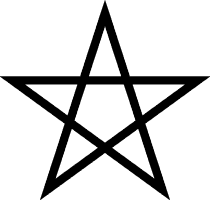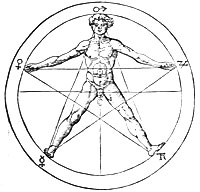Pentagram
From Thelemapedia
A pentagram or pentacle is a five-pointed star. Pentagrams were used symbolically in ancient Greece and Babylonia. The Pentagram has magical associations, and many people who practice pagan faiths wear them. Christians once commonly used the pentagram to represent the five wounds of Jesus Christ, but nowadays some Christians associate the symbol with Satanism.
Some sources refer to the pentagram as the Star of Solomon.
The word pentagram comes from the Greek word πεντάγραμμον (pentagrammon), a noun form of πεντάγραμμος (pentagrammos), πεντέγραμμος (pentegrammos) a word meaning roughly "five-lined" or "five lines".
| Table of contents |
History of the pentagram
The first uses of the pentagram we know of is in Mesopotamian writings dating to about 3000 B.C. The Sumerian pentagrams served as pictograms for the word UB; meaning "corner, angle, nook; a small room, cavity, hole; pitfall," suggesting something very similar to the pentemychos (see below on the Pythagorean use for what pentemychos means). In the Labat (dictionary of Sumerian hieroglyphs/pictograms) it is the number 306, and it is shown as being two points up. In the Babylonian context, the edges of the pentagram were probably orientations: forward, backward, left, right, and "above". These directions also had an astrological meaning, representing the five planets Jupiter, Mercury, Mars and Saturn, and Venus as the "Queen of Heaven" (Ishtar) above.
The Pythagorean use of the pentagram
The Pythagoreans called the pentagram ύγιεια Hygieia ("health" also the Greek goddess of health, Hygieia), and saw in the pentagram a mathematical perfection: among other things, the pentagram hides the golden mean, φ = (1+√5)/2 = 1.618…. When drawn with perfect angles each line is divided into several smaller segments, and if you divide the length of the longer segment with the shorter segment of any pair of segments you will get φ.
The five vertices were also used by the medieval neo-pythagoreans (whom one could argue were not pythagoreans at all) to represent the five Classical elements:
- ύδωρ, Hydor, water
- Γαια, Gaia earth
- ίδέα, Idea or ίερόν, Hieron "a divine thing"
- έιλή, Heile, heat (fire)
- άήρ, Aer, air
The vertices were labeled in the letters of υ-γ-ι-ει-α though the ordering (clockwise or counter-clockwise) used, and starting vertex, could vary.
Heinrich Cornelius Agrippa, and others, recognized the letters as being the five beginning letters of the words: udor (water, often transliterated as hydor), ge (earth, Agrippa used gaia), idea (idea as in The Platonic Idea), eile (sometimes written as heile, heat, it meant that in the Greek known to Agrippa), and aer (air). However, note that even if one uses the "elemental" scheme that Agrippa used, it's a definite stretch because it uses heat (heile), which is not an element but a quality OF the element fire. Had Agrippa used the Attic Greek, which is the language Pythagoreans back then actually spoke and wrote, he could have used (phonetic) "empreesis" for fire or conflagration.
The ancient, and one could argue real, Pythagorean pentagram was two points up and represented the doctrine of Pentemychos. Pentemychos was the title of a work written by Pythagoras' teacher and friend Pherecydes of Syros. Pentemychos means five "recesses" or "chambers" also known as the pentagonas—the five-angle. (This is actually a lost book whose contents are preserved in Damascius de principiis (quoted in Kirk and Raven, The Pre-Socratic Philosophers, Cambridge Univ. Press, 1956, page 55). It was also the "place" where the first pre-cosmic offspring had to be put in order for the ordered cosmos to appear. The pentemychos is in Tartaros.
In very early Greek thought, Tartaros was the first existing Darkness from which the cosmos is born. While it was locked away after the emergence and ordering of the cosmos, it still continued to have an influence. In fact, it was known as "the subduer of both gods and men" (Homer), and it was from this that the world got its "psyche" (soul) and its "daimon". The Boundless Darkness held influence through Mychos or Krater. Apart from being the gateway from "there" to "here" it was also a way in the opposite direction, from "here" to "there", as is evident in the many tales about how Greek heroes, philosophers and mystics descended through Mychos/Krater to Tartaros/Hades (the distinction between the two was very optional back then) in quest for Wisdom. The Underworld as the source of wisdom was the rule.
The notion of Health that is within and inside a living being, is "bounded between the rings". According to myth, Tartaros was locked away by iron (fashioned by Zeus) and bronze (fashioned by Zeus' brother Poseidon. The iron of Zeus is the aither spoken of earlier ("space") and the bronze is demiurgos, or the waterforce which binds things into matter (Poseidon was often referred to as "he who shakens the earth" and the god Proteus, who carries the seals of Poseidon has ever since Antiquity been seen as a representation of matter.) To sum it up; even if seen as the medieval elements, Living Things are the things traveling the Wheel of Life, and not directly connected to or part of the Pythagorean pentagram itself, which is at their core in the center, a Core of Inner Being (the "soul" of "the stuff"). When one had Health, they were considered Zoös and in their hearts there was Eros (the word did not mean "erotic" in the sense we mean it today at all). To not have Health was to be Thanatos - a word that does not exactly mean dead as in "dead and buried," but means dead inside but alive, like a shell.
This is an esoteric connection, but note that the Core is the Greek Goddess Kore (another name for Persephone, alongside Hecate queen of the underworld), whose symbol was the apple. If you cut an apple transversally through its core, it reveals a pentagram. The apple is also still, despite Christian ideas over the years, a symbol of health. (An apple a day keeps the doctor away.)
The Pentagram and Thelema
In Thelema and much of western hermeticism, the pentagram is used to represent the microcosm - the earthly Kingdom of Malkuth. Traditionally, it represents the 4 elements - Fire, Air, Water, Earth - surmounted by the crown of Spirit (the inverted pentagram subjugates Spirit to the material world). Crowley has made many correspondences between these elements and various aspects of the Thelemic mythic complex, though it's perhaps best illustrated in his Thoth tarot. Though the pentagram is linear there is a constant flow and dynamic between the 5 elements that give rise to the foundations of human experience.
The most common application of this symbol within Thelemic magick is the Lesser Ritual of the Pentagram. This deceptively simple ritual is used to invoke or banish a given element within a defined space, attuning the practitioner to the microcosm and drawing down the macrocosm. This daily practice is no less than the foundation of the Great Work - the spiritisation of matter and it's resultant exaltation. It can be regarded as the single most important ritual in Crowley's system.
Satanic use of the pentagram
Satanists use the Pythagorean pentagram (one point down) inscribed in a double circle, with the head of Baphomet inside the pentagram. They use it much the same way as the Pythagorenas—after all, Tartaros does mean Hell in Christian teminology (the word is used as such in the Bible, referring to the place where the fallen angels are fettered). The pythagorean Greek letters are most oftenly replaced by the Hebrew letters לויתן forming the name Leviathan. Less esoteric Satanists (LaVeyan types; the ones that exist in abundance) merely use it as a sign of rebellion.
See also
References
- Agrippa, Heinrich Cornelius. Libri tres de occulta philosophia (book III, chapter xxxi).
- Cartari, Vincenzo. Le Imagini degli Dei degli Antichi.
- Wikipedia (2004). Pentagram (http://www.wikipedia.org/Pentagram). Retrieved Oct. 18, 2004.
External links
- The Pythagorean Pentacle (http://www.geocities.com/go_darkness/god-pythagorean-pentacle.html)
- The pentagram as geometry (http://mathworld.wolfram.com/Pentagram.html)
- The Pentagram by DMGould Ireland's Own Mytyhs & Magic: (http://irelandsown.net/penta2.html)
- The Pentagram and Freemasonry (http://freemasonry.bcy.ca/anti-masonry/pentagram.html)
- Pythagoreanism Web Site (http://users.ucom.net/~vegan/)


![[Main Page]](http://www.thelemapedia.org/images/logo.gif)